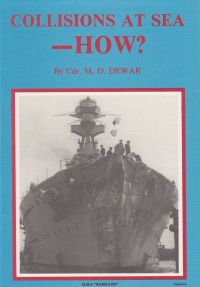
Collisions at Sea - How?
- Price:
- £150.00
Item attributes
- ISBN:
- 978-0-85174-561-9
- Published date:
- First Published 1989.
Item details
Bibliographic Notes
Written by a Royal Navy specialist navigating officer of 25 years experience which included service through World War 11. This text is unique by reason of the extent of its coverage and the analyses of the entire "build-up" to collision situations. One of Commander Malise Dewar's war duties was to make the official assessments of blame in naval collisions and groundings on one of the Royal Navy's major stations. Then, for a further 25 years following his retirement he researched and analysed in a degree of detail not often matched even by the courts involved, some 100 collisions going back just over 100 years from the 1870s.
From the factual and analytic studies of these collisions an all-important aim is to show the early "build-up" to the accidents and then explain HOW and WHY they happened. The author shows that there are typical patterns, some half-a-dozen in number, in these build-up situations. Thus the underlying object of the book is to show seafarers how they can detect these patterns before a collision becomes inevitable, so that correct and timely avoiding action can be taken.
The incidents chosen for study from the tens of thousands that happened (about three a day in the late 1960s), are selected because of the availability of the factual information which allows a detailed, complete and impartial analysis of all the relevant evidence, especially in the all-important build-up stages. From these analyses, the text offers judgements on the apportionment of blame to bridge personnel or to the ship herself. These judgements are made for solely analytic reasons; criticism of actual people is strictly avoided.
The subject of collision analysis is unpopular in certain quarters and to some extent controversial. Commander Dewar, however, has good reasons for believing that officialdom, without wishing to be officially involved, would welcome such a series of studies as he has made from his protracted research. It is believed that there exists brief official accounts of both merchant and naval ship collisions, but all are in the "classified" category. Equally, although there exist many books and journals dealing with particular collision or limited numbers of collisions, the author considers that these do not offer the searching analysis of the build-up stages when avoidance is still possible.
The book contains numerous Line Drawings and Photographs.

